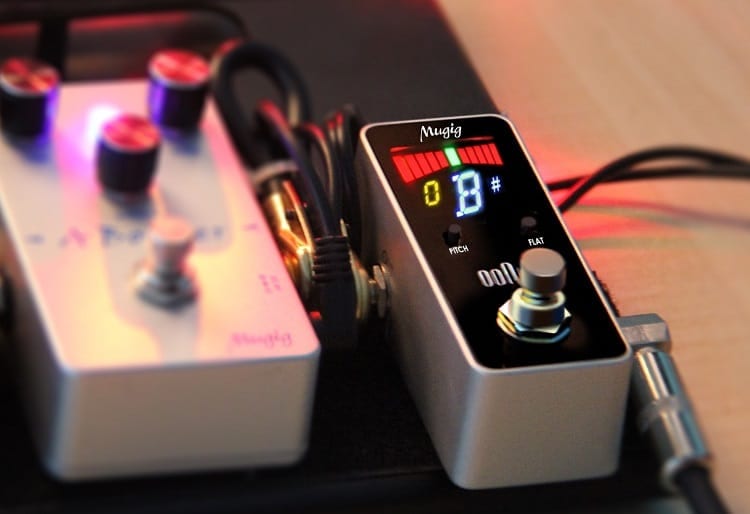Every guitarist looks forward to putting together a perfect rig, though it is considered the ultimate goal of all guitarists. It feels engaging enough and fun that you can go out for your gigs, having your favorite pedals to support you and work the way they are supposed to.
The truth is there are so many unique guitarists with several unique pedalboards, but some things might remain on the same level. So it doesn’t matter what your playing skill level is or what genre you prefer or specializes in; the need for a tuner will always come up.
It also doesn’t matter if you are having a live gig or making music in the studio; you will have to work with a tuner to ensure that things are done quickly and right. This is why we have brought you this review, which tackles what a tuner pedal does. You will understand why you need to have a tuner pedal in your setup and why it is essential to have a tuner pedal on your pedalboard as a guitarist.
What Does A Tuner Pedal Do?

Most people have no idea what a tuner pedal does or its role when it is part of your pedalboard. But, judging from its name, it shouldn’t be difficult to note that using a tuner pedal will help you stay in tune. It would help stay in tune when playing the guitar because no one will want to listen to any performer or band playing out of tune.
Furthermore, it goes deeper than just staying in tune when playing your instrument, but it also has to do with having access to a tuner pedal. This is why tuners that come in pedals will always be an excellent choice for anyone who performs music using the guitar.
One of the jobs of a tuner pedal is muting signals and ensuring that they are well-tuned. This is what you get the moment you stomp on a tuner pedal, and it will be good for you to know that no audience will be willing to listen to you as you tune your guitar.
Listening to you tune your guitar could be very annoying, and it becomes worse when you do it several times during a gig.
This is why you should go for a tuner pedal and not a conventional pedal. Focusing on tuning signals is the advantage tuner pedals have over clip-on tuners, and even though clip-on tuners are enjoyable to work with, they cut off signals using the volume knob.
Just a simple stomp on your pedalboard and you have already tuned your guitar with no one noticing, and that is what people love about tuner pedals. They are so easy and convenient to use.
What’s more about tuner pedals? The fact that tuner pedals come with a visible display shows that things will be taken care of more accessible and faster. You do not need to start shopping for a small display to attach to a guitar’s headstock.
Why You Need A Tuner Pedal In Your Setup
I’m sure you already know that it isn’t simple to work with an electric bass or electric guitar because no matter how skilled you are, there are things you have no idea about that will have a significant impact on your tone.
This isn’t a lie because science has made us believe that we learn every day, and for you to get better at things, you need to keep practicing every day. Unfortunately, most guitarists do not pay attention to or have no useful information about a buffered bypass. Even though it is considered an alternative to the true bypass, you will find out that most effect pedals have buffered bypass as one of their most essential features.
It doesn’t matter whether it is a selling point; selecting between a true bypass and a buffered bypass comes down to user preference. Back to tuner pedals come with a buffered bypass design, and having a buffer in your signal chain ensures that your tone is safe irrespective of what other guitarists think.
Tuners are top-rated because they buffer right at a signal path’s beginning, and if you do not want to start dealing with signal loss, using a buffered tuner pedal will help save the day. This explains why guitarists will opt to have a tuner pedal before a signal path.
One more thing you should know as a guitarist is a pedalboard offers you lots of versatility, and in some cases, you are presented with the option of having different loops. In most cases, having a different output for a tuner pedal is advantageous because it ensures that clean signals are constantly fed.
When placing a tuner pedal in a signal chain, you should have your tuner pedal before any effect in the signal chain. It would help if you placed your tuner pedal before any other effect so your tuner pedal can allow only clean signals to go into the pedal, resulting in viewing a precise tuning pitch.
If you place your tuner pedal after every other effect, it will distort notes and affect your signal pitch accuracy. A tuner pedal should go first because it mutes signals for silent tuning, making it the guitarist’s most loved effect pedal on his pedalboard. With a tuner pedal, you are guaranteed your audience will not notice irritating tuning sounds on stage.
If you are new to positioning pedals, you will have an idea of positioning pedals after reading this guide, and positioning your tuner pedal first before any other pedal is the best move you can make on your pedalboard. Also, looking at some professional guitar players’ videos on Youtube, you will find that they place a tuner before any other pedal in their pedalboard.
However, you can go ahead and experiment on your pedalboard to find if there is another pattern that works for you because there is no harm in finding something that suits your preference and style.
Related Posts
What Does A Compressor Pedal Do
What Does An Overdrive Pedal Do

